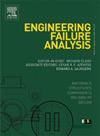Understanding the directional deformation and failure characteristics of wire arc additively manufactured Ni-based superalloy using in-situ testing and DIC
IF 4.4
2区 工程技术
Q1 ENGINEERING, MECHANICAL
引用次数: 0
Abstract
Ni-based superalloys produced by Wire Arc Additive Manufacturing (WAAM) develop pronounced columnar dendritic grains that extend in the build direction (BD) due to a steep thermal gradient acting opposite to BD, leading to anisotropic mechanical properties. While conventional tensile tests fail to resolve intrinsic crack-tip micro mechanisms, this study employs in-situ tensile testing and Digital Image Correlation (DIC) to investigate directional deformation and failure behaviour in WAAMed Inconel 625. Specimens extracted along and transverse to the BD exhibit distinct microstructural and mechanical responses. The vertical (BD) sample shows columnar dendrites with [001] texture, Nb/Mo segregation, and Laves phases (∼3.57 µm), resulting in lower yield strength (YS: 394 MPa) and ultimate tensile strength (UTS: 675 MPa) but 23 % higher elongation than the horizontal sample. In contrast, the horizontal sample exhibits 31 % higher YS (519 MPa) and 14 % higher UTS (772 MPa), attributed to increased strain hardening and a higher fraction of low-angle grain boundaries (LAGBs: 42 %). DIC reveals higher notch sensitivity in the horizontal sample, while the vertical sample demonstrates rapid strain hardening near yield (9931 MPa vs. 5627 MPa). These findings highlight the critical role of grain orientation and Laves phase distribution in governing anisotropy, providing actionable insights for designing WAAM components for multiaxial loading applications.
采用原位试验和DIC方法研究电弧增材制造镍基高温合金的定向变形和破坏特征
采用电弧增材制造技术(WAAM)生产的镍基高温合金,由于与构建方向(BD)相反的陡峭热梯度,形成明显的柱状枝晶晶粒,导致其力学性能各向异性。传统的拉伸试验无法解决裂纹尖端的内在微观机制,本研究采用原位拉伸试验和数字图像相关(DIC)来研究WAAMed Inconel 625的定向变形和破坏行为。沿BD和横向提取的标本表现出明显的微观结构和力学反应。垂直(BD)样品显示出具有[001]织构、Nb/Mo偏析和Laves相(~ 3.57µm)的柱状枝晶,导致屈服强度(YS: 394 MPa)和极限抗拉强度(UTS: 675 MPa)较低,但伸长率比水平样品高23%。相比之下,水平试样表现出31%的高YS (519 MPa)和14%的高UTS (772 MPa),这是由于应变硬化增加和低角度晶界的更高比例(LAGBs: 42%)。DIC在水平试样中显示出更高的缺口敏感性,而垂直试样在屈服附近表现出快速应变硬化(9931 MPa vs 5627 MPa)。这些发现强调了晶粒取向和Laves相分布在控制各向异性中的关键作用,为设计用于多轴加载应用的WAAM组件提供了可行的见解。
本文章由计算机程序翻译,如有差异,请以英文原文为准。
求助全文
约1分钟内获得全文
求助全文
来源期刊

Engineering Failure Analysis
工程技术-材料科学:表征与测试
CiteScore
7.70
自引率
20.00%
发文量
956
审稿时长
47 days
期刊介绍:
Engineering Failure Analysis publishes research papers describing the analysis of engineering failures and related studies.
Papers relating to the structure, properties and behaviour of engineering materials are encouraged, particularly those which also involve the detailed application of materials parameters to problems in engineering structures, components and design. In addition to the area of materials engineering, the interacting fields of mechanical, manufacturing, aeronautical, civil, chemical, corrosion and design engineering are considered relevant. Activity should be directed at analysing engineering failures and carrying out research to help reduce the incidences of failures and to extend the operating horizons of engineering materials.
Emphasis is placed on the mechanical properties of materials and their behaviour when influenced by structure, process and environment. Metallic, polymeric, ceramic and natural materials are all included and the application of these materials to real engineering situations should be emphasised. The use of a case-study based approach is also encouraged.
Engineering Failure Analysis provides essential reference material and critical feedback into the design process thereby contributing to the prevention of engineering failures in the future. All submissions will be subject to peer review from leading experts in the field.
 求助内容:
求助内容: 应助结果提醒方式:
应助结果提醒方式:


